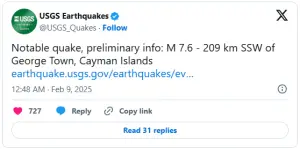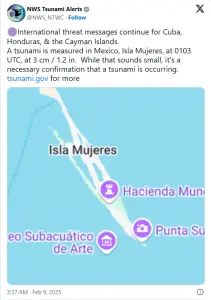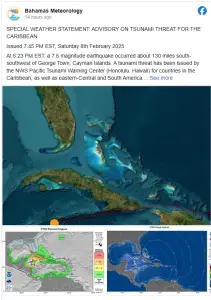I. Overview of the Seismic Event
Late Saturday evening, as darkness fell over the Caribbean, a violent quake measuring 7.6 on the Richter scale jolted the seabed near the Cayman Islands. The powerful earthquake, which struck at 23:23 UTC on February 8, 2025, had its epicenter located at 17.8°N latitude and 82.5°W longitude, with a shallow depth of approximately 33 kilometers. Seismologists have described the quake as one of the strongest to impact this region in recent years, noting that its significant magnitude and shallow depth could result in considerable ground shaking and the potential to trigger secondary hazards.

The earthquake’s force was felt over a wide area. Many coastal communities in the Caribbean and parts of Central America experienced strong tremors, and residents reported feeling the ground convulse in a series of sharp jolts. The seismic activity, occurring beneath the ocean, raised immediate concerns about the possibility of tsunami waves generated by the sudden displacement of water.
II. Tsunami Warnings and Expected Impact
A. Issuance of Tsunami Alerts
In response to the earthquake, the Pacific Tsunami Warning Center (PTWC) swiftly issued tsunami warnings for several coastal areas. The agency reported that tsunami waves are expected to reach hazardous levels, with waves forecast to be between 1 to 3 meters above tide level along the coast of Cuba. Parts of Honduras and the Cayman Islands could experience smaller waves, ranging from 0.3 to 1 meter. These warnings are precautionary measures, as tsunami waves are typically not a single surge but rather a series of surges that can vary in size and arrive in intervals of five minutes to an hour. The overall threat may persist for several hours, necessitating ongoing vigilance by local authorities.

B. Estimated Tsunami Arrival Times
According to data from the PTWC, the first tsunami waves are expected to reach affected regions on February 9, 2025, within a few hours of the earthquake. Estimated arrival times (UTC) for the tsunami waves are as follows:
- Puerto Cortés, Honduras: Approximately 00:22 UTC
- Trujillo, Honduras: Approximately 01:08 UTC
- Santa Cruz del Sur, Cuba: Approximately 03:00 UTC
- Nueva Gerona, Cuba: Approximately 03:50 UTC
Officials emphasized that the forecasted wave heights are subject to change depending on local geographic features and underwater terrain. For instance, coastal areas with protective barrier reefs and atolls might experience significantly lower wave impacts than initially predicted.
III. Official Responses and Ongoing Monitoring
A. Emergency Mobilization and Public Advisories
Following the seismic event, local emergency services and national agencies sprang into action. Coastal authorities in the affected areas have been closely monitoring sea-level gauges and other instruments to determine the full extent of the tsunami threat. Residents along vulnerable coastlines have been advised to evacuate to higher ground immediately, and public shelters have been established in areas where there is a significant risk.

Officials from the PTWC and regional agencies have stressed that residents should remain alert and follow instructions from local authorities. In addition to evacuation orders, communities are being advised to avoid beaches, coastal roads, and low-lying areas until the threat has subsided.
B. Updates from U.S. Agencies
The U.S. Geological Survey (USGS) acknowledged the earthquake with a social media update stating:
“Notable quake, preliminary info: M 7.6 – 209 km SSW of George Town, Cayman Islands.”
This update underscores the significant reach of the seismic event, which has captured the attention of both national and international agencies.
Hours after the quake, the U.S. National Tsunami Warning Center issued a series of updates via social media. In one update, the agency confirmed that, based on the latest modeling and observations, the tsunami threat had subsided for the United States and its international partners. The message read:
“With the latest modeling and information, the tsunami threat has passed. There are no alerts posted for the United States or International Partners. Unusual currents may be noticed in some areas; exercise normal caution.”
Although this update provided relief for residents in the United States, warnings remained active for coastal regions in Cuba, Honduras, and the Cayman Islands. For example, a small tsunami wave measuring 3 cm (1.2 inches) was recorded near Isla Mujeres, Mexico, at 01:03 UTC, confirming that tsunami activity was indeed underway, albeit on a smaller scale in that specific location.
C. Alerts for the Bahamas and Turks and Caicos Islands
Additional alerts have been issued by the Bahamas Department of Meteorology, which released a special weather statement cautioning coastal communities about the potential impacts of elevated sea levels. The advisory, issued at 7:45 PM EST on February 8, 2025, noted that the earthquake had struck approximately 130 miles south-southwest of George Town, Cayman Islands. Consequently, the PTWC had extended tsunami warnings to include several areas across the Caribbean, Central America, and South America.
The advisory for the Bahamas specifically warned that coastal regions in the Southeast Bahamas—including Ragged Island, Crooked Island, Acklins, Mayaguana, and Inagua—might experience significant impacts from rising sea levels. The Turks and Caicos Islands were also included in the advisory, with local authorities urging residents to stay vigilant and to monitor official updates closely. Evacuations could be ordered in some areas, depending on the severity of the conditions.
IV. Assessing the Broader Implications
A. Historical Context and Regional Vulnerability
The Caribbean region is known for its geological volatility. The area is situated near major tectonic plate boundaries, making it particularly susceptible to earthquakes and related hazards such as tsunamis. Historically, the Cayman Islands and surrounding nations have experienced several significant seismic events, which have shaped both public policy and community preparedness initiatives. This latest earthquake, with its considerable magnitude of 7.6, is being closely compared to past events to assess potential damage and the likelihood of secondary disasters.
Local communities, many of which are built on or near coastal areas, remain acutely aware of the risks. Governments have invested in early warning systems and robust emergency response protocols to mitigate the impact of such natural disasters. However, experts warn that even with these measures in place, the threat of a tsunami can never be fully eliminated, and preparedness is essential for minimizing loss of life and property damage.
B. The Role of Modern Technology in Disaster Response
In response to events like this, modern technology plays a crucial role. Seismic monitoring stations, satellite imagery, and advanced computer models help agencies predict tsunami arrival times and potential impacts. The use of automated warning systems and real-time data collection allows for rapid dissemination of critical information to the public. These technological advances have improved the speed and effectiveness of emergency responses, providing communities with precious time to evacuate and seek safety.
Local and international agencies, including the PTWC and USGS, continue to collaborate closely, sharing data and coordinating response efforts across borders. This multi-agency cooperation is essential for managing the complex and rapidly evolving nature of natural disasters in a region as geologically active as the Caribbean.
C. Community Preparedness and Public Awareness
For residents of the affected areas, the recent earthquake and subsequent tsunami warnings serve as a stark reminder of the importance of community preparedness. Authorities have repeatedly stressed the need for individuals living in coastal regions to have an evacuation plan, to stay informed through official channels, and to heed warnings promptly. Schools, local businesses, and community centers have been activated as temporary shelters, and residents are encouraged to keep emergency kits stocked with essential supplies.
In the aftermath of this event, community leaders and local governments are expected to review and, if necessary, update their disaster response plans. Public education campaigns focusing on the importance of tsunami preparedness and earthquake safety are likely to be intensified, ensuring that future events are met with even greater readiness and coordinated action.
V. Looking Ahead: The Road to Recovery and Resilience
A. Short-Term Response and Recovery Efforts
In the immediate aftermath of the earthquake, emergency services and government agencies are working around the clock to assess the damage and to provide aid to affected communities. Rescue operations have been mobilized along key coastal areas, and officials are working to ensure that anyone in harm’s way is evacuated to safety. Coordination between local authorities and international agencies is ongoing, with efforts focused on both immediate relief and long-term recovery planning.
Preliminary assessments suggest that while the earthquake has the potential to cause significant structural damage in some areas, the presence of natural barriers such as coral reefs and atolls may help mitigate the impact of tsunami waves on certain coastlines. Nevertheless, experts caution that the risk remains high and that residents should continue to follow all instructions from local officials.
B. Long-Term Implications for Regional Infrastructure
The earthquake has raised important questions about the resilience of infrastructure in the Caribbean region. Many communities, particularly in smaller island nations, face ongoing challenges related to building construction, urban planning, and disaster preparedness. In the wake of this event, governments may need to invest in more robust construction standards and improved coastal defenses to better protect against future seismic events and tsunamis.
The economic impact of such natural disasters can be profound, affecting tourism, local businesses, and overall community stability. Recovery efforts will likely involve significant investment in rebuilding damaged structures, restoring critical services, and supporting vulnerable populations. In this context, the lessons learned from this earthquake may prompt a broader reexamination of how communities in the region prepare for and respond to natural hazards.
C. Enhancing Regional and International Cooperation
Events like the 7.6-magnitude earthquake serve as a catalyst for enhanced regional and international cooperation in disaster management. The collaborative efforts between agencies such as the PTWC, USGS, and local governments underscore the importance of sharing information and resources during times of crisis. Moving forward, there is a growing recognition that natural disasters do not respect national borders, and that a coordinated, global response is essential for minimizing harm and ensuring swift recovery.
International organizations and humanitarian agencies are expected to play an increasingly important role in supporting recovery efforts, providing both technical expertise and financial assistance. This collaboration not only strengthens the response to the current event but also helps build a more resilient framework for future emergencies.
VI. Conclusion
The powerful 7.6-magnitude earthquake that struck near the Cayman Islands on February 8, 2025, has sent shockwaves through the Caribbean and beyond, triggering tsunami warnings for coastal regions in Cuba, Honduras, and the Cayman Islands. As authorities work tirelessly to monitor and mitigate the impact of this seismic event, the incident serves as a sobering reminder of the natural forces that shape our world.
Through rapid emergency responses, coordinated regional efforts, and the use of advanced technology, officials are striving to ensure that the loss of life and property is minimized. Yet, the event also highlights the need for continued investment in disaster preparedness and resilient infrastructure—a challenge that the affected regions must address in order to safeguard their communities against future threats.
As residents brace for the arrival of tsunami waves and prepare for the potential fallout from this massive earthquake, the world watches with bated breath. The coming hours and days will be critical as local authorities implement evacuation orders, set up emergency shelters, and coordinate rescue operations. For now, the primary focus remains on ensuring public safety and providing timely information to all those at risk.
In the midst of uncertainty and fear, there is also a lesson in unity and preparedness. The coordinated response by international and local agencies, the use of real-time data to predict wave arrival times, and the active efforts to educate communities on safety measures are all steps in the right direction. While the threat of further aftershocks and additional tsunamis remains, the ongoing commitment to transparency and public communication offers hope that the worst can be mitigated.
This earthquake, with its far-reaching consequences, underscores the importance of global cooperation and the resilience of communities in the face of natural disasters. It is a call to action for governments, agencies, and citizens alike to remain vigilant, prepared, and united in the pursuit of safety and recovery.
As further updates are released and the situation continues to develop, it will be crucial to stay informed through reliable sources and to heed the advice of emergency officials. In the end, the collective response to this tragedy will determine not only the immediate impact on the affected regions but also the long-term resilience of communities across the Caribbean and beyond.

